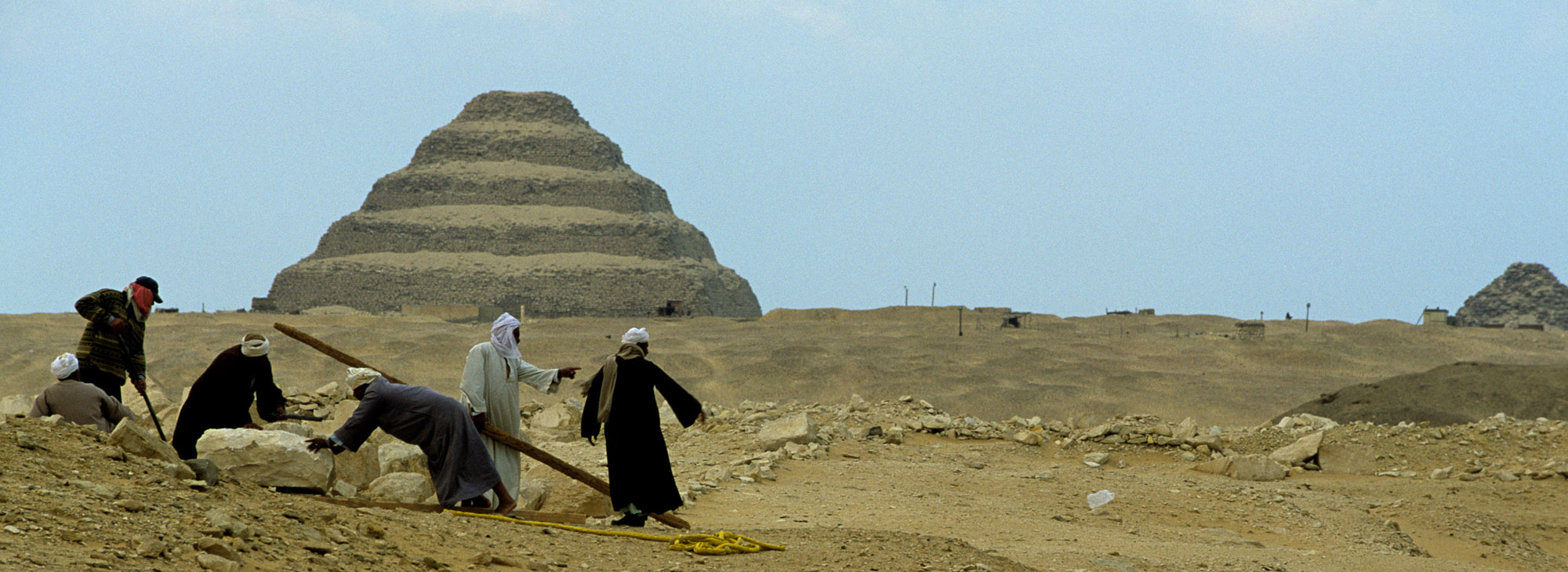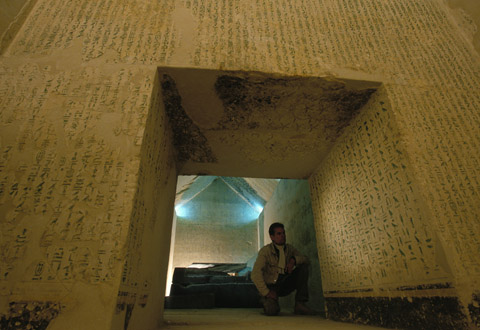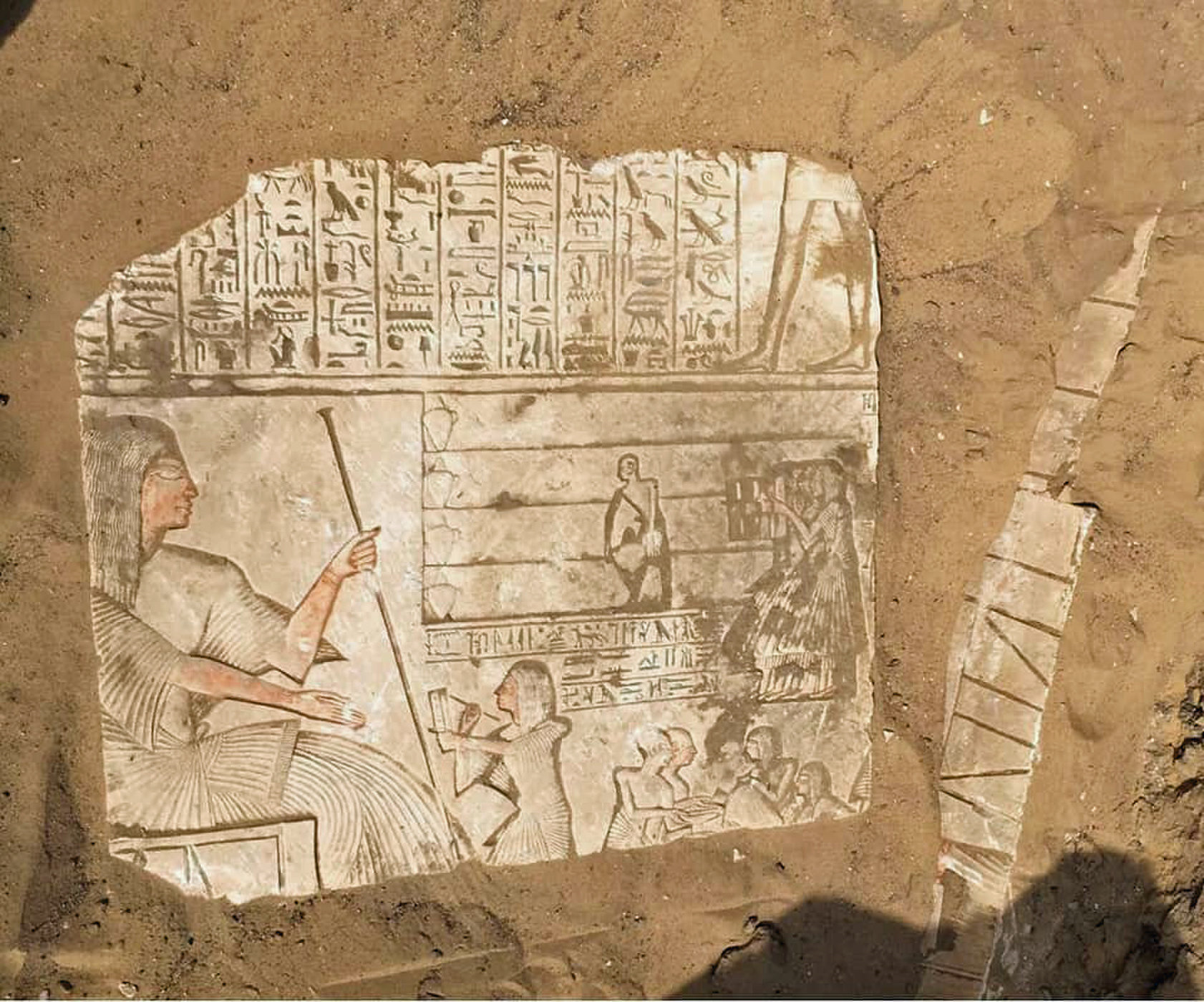Saqqara
Saqqara, the sweeping necropolis and pyramid field of Memphis, the first Capital of Egypt, has been an important historical site for 5,000 years of Egyptian history. This large area about 20 miles south of Cairo features the small square tombs (mastabas) of the kings of the first and second dynasties Most famously, the first king of the third dynasty, Djoser, asked his vizier and chief architect to erect for him the first monument built entirely of stone in ancient Egypt. The result is the famous step pyramid of Saqqara and its surrounding funerary complex, which was enclosed by a huge wall, probably emulating that which surrounded Memphis itself.
While kings of the fourth dynasty selected the Giza Plateau for their funerary monuments, kings of the fifth and sixth dynasties returned south to Saqqara where we find their pyramids and most of their high officials’ tombs. The importance of the necropolis region ebbed back and forth as the capital of Egypt moved, first, to the city of iTt-tAwy in the Middle Kingdom’s 12th dynasty, and then to the south in the New Kingdom to Thebes, where Amun became the State-god. The situation changed again for the brief “Amarna Interlude,” when King Amenophis IV (Akhenaten), built Tell el Amarna in Middle Egypt as his new capital. The New Kingdom royal necropolis was then moved south to Western Thebes in the reign of Amenhotep I, to what is known now as the Valley of the Kings and Valley of the Queens. Most of the high officials and noblemen of this period were also buried in the cliffs of Western Thebes.
Yet these shifts of the capital did not undermine the importance of Memphis as an administrative center and a military post. Amenophis III built a new temple at Saqqara for the Memphite god Ptah, and the Apis Bulls – symbols of Osiris the god of the underworld – were buried at Saqqara as well. Because of the military importance of Memphis, many official and generals settled there and were buried at Saqqara. This trend started from the 18th-dynasty reigns of Thutmosis III and Amenophis III, and continued to the Ramesside period (19th dynasty).
The four most important sectors of the New Kingdom necropolis in Saqqara are:
- 1. North and east of the pyramid of King Teti (6th dynasty): Tombs were built above Old Kingdom tombs and close to Teti’s temple.
- 2. The eastern cliff: This area, known as the Bubasteion or catacombs for the cats of the Cat-goddess Bastet, dates to the Late Period. Here, rock cut tombs were dug from the beginning of the 18th dynasty – including the Amarna Period – up to the time of Ramses II. The most renowned tombs in this cliff are for Aper-El, vizier of Amenophis III; Maya, wet-nurse of king Tutankhamun and the Hatiay scribe of the Aton temple in Memphis.
- 3. South of the King Unas (5th dynasty) causeway: This structure leads to the king’s pyramid, the first in history to have religious texts (Pyramid Texts) on the walls of its burial chamber.
- 4. Saqqara North, south of Abusir: Rock-cut tombs here date to the 19th dynasty, mainly to the time of King Ramses II.
Chronologically, New Kingdom tombs in Saqqara can be arranged into the Pre-Amarna period, the Amarna period and the Post-Amarna period. The necropolis south of the Unas causeway is best known for its New Kingdom tombs of officials who cover all of these periods. There, stand-alone, temple-like tombs were erected in a somewhat longitudinal line running south to north. Meanwhile, the tombs’ axis was always east-west, with their pylon gate entrances to the east and their sanctuaries or “holy of holies” to the west.
In the 19th century, when parts of these tombs still showed above ground, clandestine excavations and looting swept through Saqqara. As a result, many tomb walls were dismantled and their remnants moved to museums around the world. Thankfully, Karl Richard Lepsius and other scholars visited during this era to record what could be seen, leaving essential documentation to inform the formal excavations to come. This pioneering field work began in 1975, led by Geoffrey Martin and the Egypt Exploration Society (EES) in London. Martin was looking for the tomb of Maya, overseer of the treasury in the time of Tutankhamun. Instead, he found the intended tomb of Horemheb, commander in chief of the army of Tutankhamun. Horemheb later became a ruler himself and was buried in the Valley of the Kings.
In the 1980s, the Dutch mission from Leiden Museums joined the EES team, discovering many tombs of the 19th dynasty. At the same time, Cairo University began excavations headed by Professor Said Tawfik. The result: about 35 tombs were uncovered from 1982-86, most belonging to high officials from the time of Ramses II. These tombs featured the same style and nearly the same architecture as those of the adjoining site. The best-preserved are built of mud brick covered with a limestone revetment (wall), including the tomb of Ramses II’s vizier, whose coffin is still on the site; the tomb of a father and son; and another father-son tomb featuring a family stela. The deep shaft of this tomb proved interesting, as it was reused on different levels for burials dating up to the Late Period.
In 2005, a Cairo University team from the Faculty of Archaeology resumed excavations at Saqqara under my direction. The site immediately began to reveal more tombs of administrative and military officials from the Ramesside period, including the tomb of the mayor of Memphis, royal scribe and head of the treasury, head of the state granaries and a general during the reigns of Sethi I and Ramses II. This tomb has long been sought because a number of its inscribed blocks, statues and pillars were moved in the 19th century to museums outside Egypt.
Famous scenes of what is known as the Devéria Wall, photographed by a French explorer around 1853, were part of the walls in this tomb. The lower register of this scene was found still in place, but the upper registers are missing and not found in any museums or collections. The plan of this tomb resembles that of Maya, which dates to the reign of Akhenaten: a large forecourt-statue room features lateral vaulted storehouses, with a peristyle court and tripartite sanctuary topping a pyramidion.
Also uncovered was the tomb of a royal envoy to all foreign countries and overseer of the guards of the army archive in the Ramesside period. The tomb is smaller than others, but its limestone blocks bear exquisite scenes and interesting inscriptions reflecting the art of the Ramesside period. This tomb is formed by a portico entrance and a small peristyle court with a tripartite sanctuary and a center burial shaft.
In the 2017-18 excavations to the north of these tombs, we found the tomb of the general, Iwrhya (iwrxy), his son and grandson. While excavations are continuing, the reliefs found in or near this site, plus the dimensions of the uncovered walls, indicate the tomb must have been large and had more than one owner. The wall scenes of the statue room display daily activities in a maritime or river port on the eastern frontiers of Egypt (probably the Tell Hebwa fortress), with boats unloading their freights of oil jars and storing them in magazines as well as other daily activities.
One of the most important scenes from this tomb was found on a fragment of wall that had fallen among the debris. The scene depicts an army of infantry and cavalry leaving the gates of the fortress to cross what is probably a canal that had crocodiles in the water. The conservation work on this tomb resumed in 2018-19.


